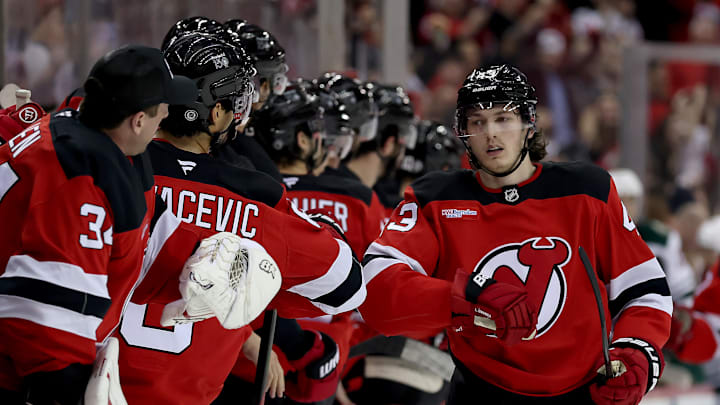This week, the NHL community saw two young and promising defensemen get paid akin to the NHL elite. But a common issue in this development will be determining if these players are really worth the 9-million-dollar AAV that they have been bestowed by their teams' general managers. While only time will tell if their contracts will age like milk or wine, let's set the stage and examine the current stories of these young men.
Jackson Lacombe
Starting with the most recent signing, defenseman Jackson Lacombe of the Anaheim Ducks. On October 2nd, 2025, the Anaheim Ducks signed left-handed defenseman Jackson LaCombe to an 8-year deal with a $9-million AAV. This comes only a few days after the Ducks extended second-line center Mason McTavish to a 6-year extension worth $7 million AAV, putting an end to a three-month standstill.
After analyzing Lacombe’s statistics of his two full years in the NHL, the statistics do not remotely resemble the price of a 72 million dollar player. Lacombe, in his two years in the NHL, has scored 16 total goals and 44 assists for 60 points in 146 games played. While it may sound unfair to compare him to a fellow $9-million club member in Cale Makar, who is a generational defenseman and arguably the best defenseman in the NHL, Lacaombe is currently making the exact same amount of money, so it's time to provide a dose of reality.
Makar, in his first stint in the NHL, put up 12 goals and 38 assists for 50 points in only 57 games compared to Lacombe, who only potted 2 goals and 15 assists in 71 games. Now, the most common rebuttal that can be used in Lacombe’s defense is that Makar currently plays on a team with Nathan Mackinnon and is partnered up with fellow star Devon Toews.
But let's not forget that both players, in their first year in the NHL, were both rebuilding teams that were poised to take the next step in their rebuilds. The main difference, besides skill, is that Makar won a Calder Trophy and was a Norris Trophy Finalist before being extended in 2021, while Lacombe is now the highest-paid member of a franchise that hasn’t made the playoffs since 2018.
Luke Hughes
Lacombe is a decent player and a promising defenseman; there is no doubt that he has been a glow in the dark in the Anaheim Ducks organization. So let's give him a fair chance; instead of comparing him to a future Hall of Famer in Cale Makar, let's compare him to another defenseman that was similarly paid last week in Luke Hughes.
The third Hughes brother, who has also played two full seasons in the NHL, has put up decent numbers with 17 goals and 76 assists for 93 points in 155 games. On the other hand, Lacombe has scored 16 goals and 44 assists for 60 points in 148 games played. While they seem to be on the same landscape when it comes to scoring, Lacombe scored 14 goals this season, while Hughes has his scoring more spread out with 7 goals this year and 9 goals in 2023-24.
While it can be argued that both of these defensemen have had too much money thrown at them, a statement in which this series will subscribe to, Luke Hughes has displayed at least a sliver of consistency, while Lacombe has only recently exploded in production. It can also be argued that Luke Hughes was producing alongside veteran presences such as Dougie Hamilton and Brett Pesce, while Lacombe is projected to spend another year alongside Radko Gudas; both cases are still a perfect display of taking too high of a risk in investing so much cap space in two players that have much to prove.
The Bottom Line
A common theme of this series will be highlighting a critical issue that is plaguing the NHL nowadays, in which many of the league’s youngest budding stars are demanding their money up front. From players in Matthew Knies and Frank Nazar to defensemen in Jackson Lacombe and Luke Hughes, the league’s managers are currently trending to paying a player for what they could receive rather than balancing the scales of their consistency in production to determine their worth.
Sure, there is a case to be made that many of these players could be on the brink of assuming larger roles with their teams. Luke Hughes will likely become the New Jersey Devil's top defenseman, foreshadowing an imminent cap dump move from Dougie Hamilton, while Jackson Lacombe is currently projected to share responsibility with fellow left-handed defenseman, Pavel Mintyukov.
But the essential quetsion that will be repeated throughout this series, that could serve as a warning for the future, is a simple one: What if it doesn't pan out? What if both LaCombe and Luke Hughes regress and dissapoint? It was already covered that at least Luke Hughes has the consistency to alleviate the fear and concern from Devils' fans, but LaCombe's future production is much more shrouded in mystery. A perfect example would be Brock Faber of the Minnesota Wild who immediately entered a post-pay day slump after being paid a similar long-term contract by the Wild.
The league is currently trending towards a player’s league, and it should be clarified that this series isn't meant to demonize players but instead to showcase that many of these players that are being handed generational wealth still have much to prove. At the end of the day, it isn't solely the general managers and owners that pay the players, but it is the fans themselves that pay to see them play and perform to a higher standard.
